All of us mammals were born with two eyes, and when something goes wrong with one of them, help should be sought. We see a variety of eye abnormalities in companion animal medicine. Here are some examples…
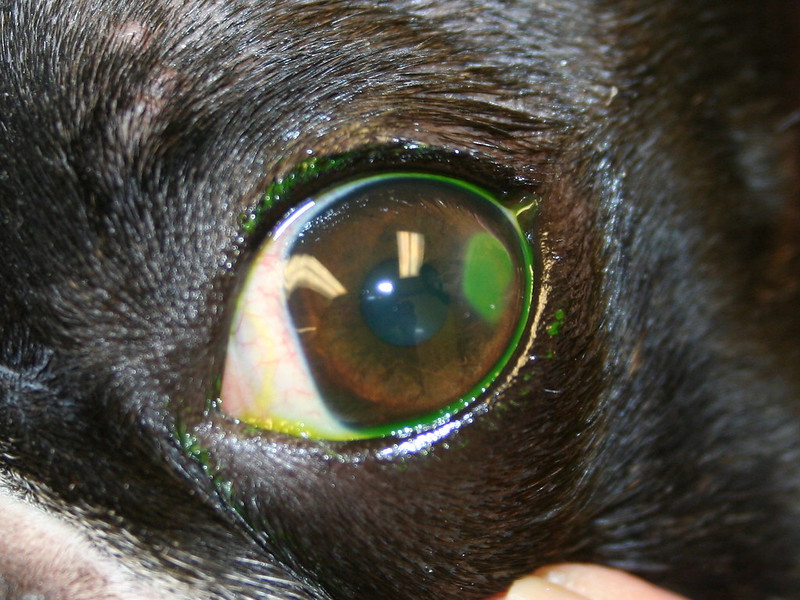 The most common eye trouble that we see is the corneal ulcer. When something injures/scratches the cornea, the eye becomes irritated and the ulcer can become infected. An ulcer is diagnosed with a special stain, and treatment involves appropriate antibiotics treatment and lubrication. Ulcers should be treated aggressively as they can only get so deep before the eye is irreversibly injured. The most common eye trouble that we see is the corneal ulcer. When something injures/scratches the cornea, the eye becomes irritated and the ulcer can become infected. An ulcer is diagnosed with a special stain, and treatment involves appropriate antibiotics treatment and lubrication. Ulcers should be treated aggressively as they can only get so deep before the eye is irreversibly injured. |
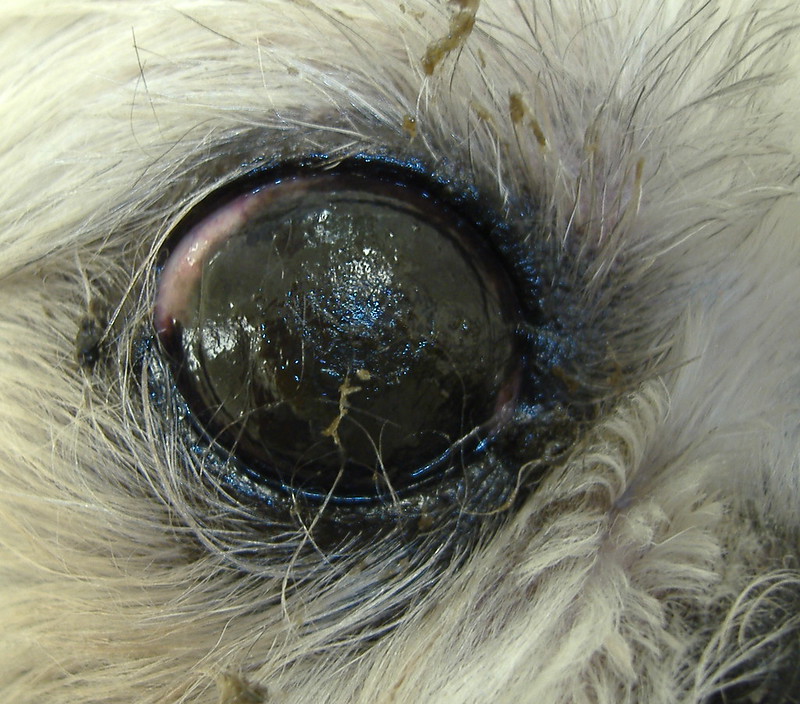 Just as people can suffer from dry-eye, dogs can as well. When the tear glands don’t produce sufficient tear for appropriate lubrication, the eye becomes dry, crusty and uncomfortable. In response, many dogs will deposit pigment on their corneas leading to vision impairment. Just as people can suffer from dry-eye, dogs can as well. When the tear glands don’t produce sufficient tear for appropriate lubrication, the eye becomes dry, crusty and uncomfortable. In response, many dogs will deposit pigment on their corneas leading to vision impairment. |
 Eosinophilic plaques are cellular accumulations on top of the cornea and are quite uncomfortable for cats. Eosinophilic plaques are cellular accumulations on top of the cornea and are quite uncomfortable for cats. |
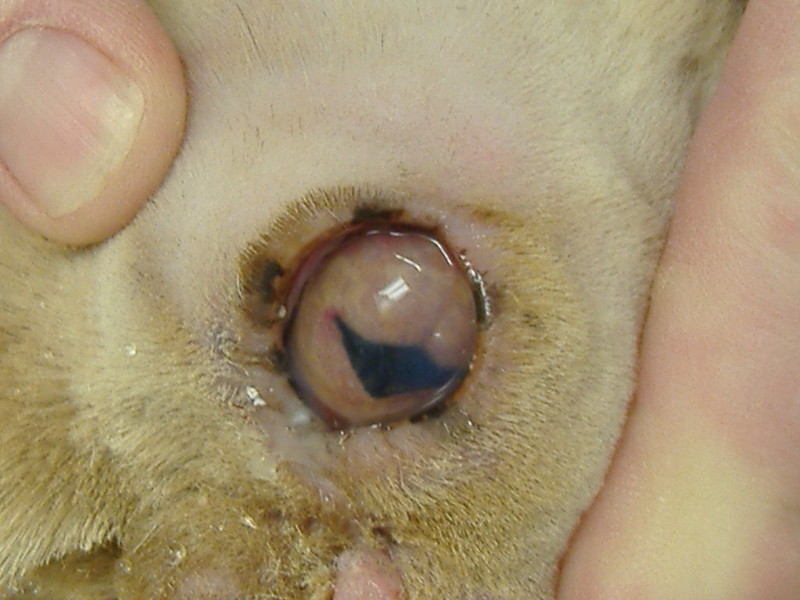 When cancer shows up as a tumor within the eye, the pressure within the eye increases and the tissue around the eye can become inflamed. When cancer shows up as a tumor within the eye, the pressure within the eye increases and the tissue around the eye can become inflamed. |
 Iris cysts rarely need to be treated, though they can burst and coat the back of the cornea with pigment. Iris cysts rarely need to be treated, though they can burst and coat the back of the cornea with pigment. |
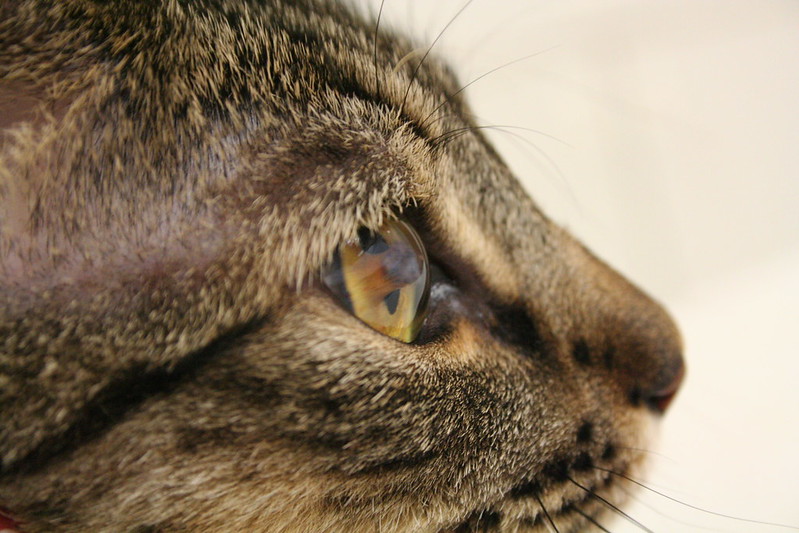 Synechia is an attachment of the iris to either the cornea or the lens. In this case, the cat suffered an full-thickness injury to the cornea, and in the healing process, the iris stuck to the back side of the cornea. Synechia is an attachment of the iris to either the cornea or the lens. In this case, the cat suffered an full-thickness injury to the cornea, and in the healing process, the iris stuck to the back side of the cornea. |
Some eye abnormalities have been present from birth. Persistent pupillary membranes aren’t normal, but there’s no reason to pursue treatment for them. Persistent pupillary membranes aren’t normal, but there’s no reason to pursue treatment for them.
 Dermoids are the presence of haired skin on the eye. These should be surgically removed… with great care! Dermoids are the presence of haired skin on the eye. These should be surgically removed… with great care! |
This is by no means an exhaustive list of the ophtho abnormalities that we see. We also see glaucoma and uveitis on a regular basis, though photographs don’t illustrate those conditions too terribly well. Hopefully, though, this enough of a sampling for you to see that anything unusual with an eye ought to be examined by a veterinarian.
Some of the conditions above need immediate treatment while others are unusual, but not impacting the animal’s quality of life.
For those that need immediate treatment, ignoring the problem could cost the patient an eye, and if treatment is needed, necessary treatment ought not be delayed.
Concerned about something with your four-legged friend’s eye? Call us at 330-929-3223.
(The photos included in this post are property of the Cuyahoga Falls Veterinary Clinic. All rights reserved.)









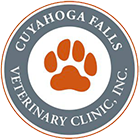
Ruby
I came home to find my dog had hos left eye swollen and bloody. The vet told me he couldnt do anything until a few days I cant take him until monday so I wanted to know what can I donso his eye wont get infected.
Dr. Ryan Gates
The staff of CFVC is instructed to work eye cases in ASAP, and we encourage our colleagues to do the same. Little harm can come from applying a viscous tear replacer, but in the absence of a diagnosis, this may not be helpful either. When eyes are a concern, we recommend finding a veterinarian who can accommodate you quickly.